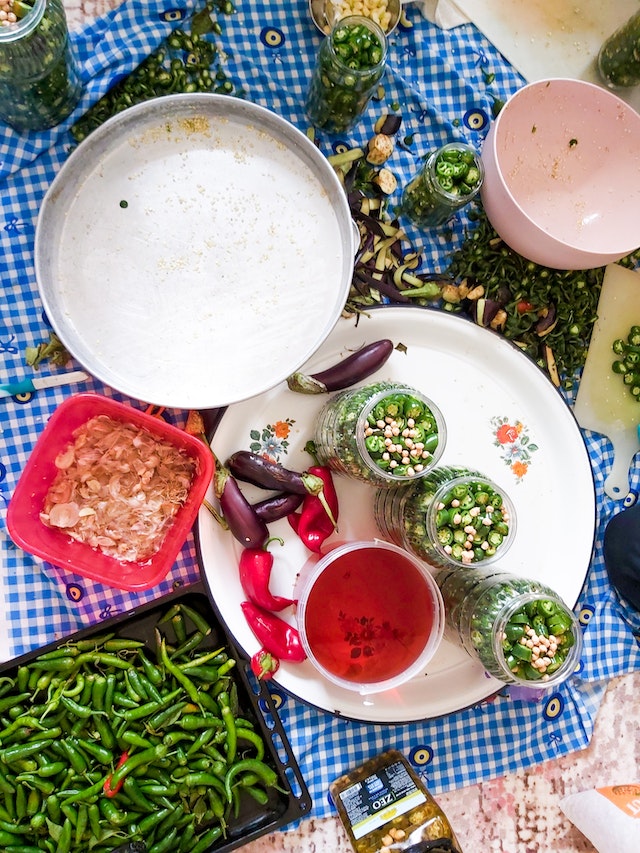
As the seasons change, so do the bounties of nature. There is an undeniable magic to embracing fresh ingredients that are abundant during each time of year. From crisp apples in the fall to juicy berries in the summer, seasonal produce brings a burst of flavor and vitality to our meals. In this guide, we will explore the art of seasonal meal prep, uncovering the delicious possibilities that await us in every season. So, let us embark on a culinary journey, discovering how to make the most of nature’s gifts and nourish ourselves with vibrant, wholesome dishes.
Benefits of Seasonal Eating
Eating seasonally has numerous benefits for both our health and the environment. By embracing the practice of seasonal meal prep, we not only support local farmers and reduce our carbon footprint but also maximize the nutritional value of our meals. Let us delve into the incredible advantages of making seasonal ingredients the star of our culinary creations.
Nutritional Superiority
When we consume fruits and vegetables that are in season, we enjoy their peak freshness and flavor, but that’s not all. Seasonal produce also tends to be more nutritious compared to out-of-season options. As fruits and vegetables ripen naturally on the vine or tree and are harvested at the right time, they develop a higher concentration of essential vitamins, minerals, and antioxidants. These natural compounds not only boost our immune system but also help fight against numerous diseases.
Cost-Effectiveness
One of the delightful aspects of seasonal eating is its cost-effectiveness. When ingredients are in abundance, their prices tend to be lower. By planning our meals around what’s in season, we can take advantage of the greater availability and affordability of these fresh ingredients. Not only does this save us money, but it also allows us to support local farmers and contribute to our community’s economy.
Culinary Adventure
As each season unfolds, it brings with it a diverse array of ingredients, offering endless culinary possibilities. Embracing seasonal eating encourages us to step out of our culinary comfort zones and experiment with new flavors, textures, and cooking techniques. By exploring the unique qualities of each season’s bounty, we can expand our palate and develop a deeper appreciation for the natural cycle of food.
Connection to Nature
In our fast-paced, modern lives, it’s easy to feel disconnected from the natural world. Engaging in seasonal meal prep provides an opportunity to reconnect with the rhythms of nature. As we savor the flavors of each season, we become more attuned to nature’s cycles and rediscover a sense of wonder in the simple beauty of fresh, nourishing ingredients. This connection not only enhances our cooking experience but also fosters a greater respect for the earth’s resources.

Environmental Sustainability
Eating seasonally directly contributes to reducing our carbon footprint. Out-of-season produce often comes from far-off places and requires extensive resources for transportation, leading to increased greenhouse gas emissions.
In contrast, seasonal ingredients are sourced locally, typically requiring less transportation and fewer artificial interventions like refrigeration or pesticides. Choosing seasonal meal prep means making a conscious choice to support sustainable food production practices and protect our planet.
Planning Seasonal Menus
When it comes to seasonal meal prep, a little bit of planning goes a long way. By taking the time to thoughtfully design your menus, you can ensure that your meals are not only delicious but also fully aligned with the flavors and ingredients of the season. Follow these simple steps to create a well-rounded, seasonal menu that will have your taste buds dancing with joy.
Step 1: Embrace the Season’s Stars
Every season has its shining stars – those fruits, vegetables, and herbs that are at their peak in terms of flavor and freshness. Begin your menu planning by identifying these star ingredients. Pay attention to what’s available at your local farmers market or grocery store, and explore recipes that showcase the unique qualities of these seasonal gems. For example, if it’s summer, juicy tomatoes and fragrant basil might take center stage, while in the fall, it could be vibrant squash and crisp apples.
Step 2: Balance the Plate
A balanced meal is a nourishing meal, and creating balance is key to planning a seasonal menu. Aim to include a variety of food groups in each meal – a good mix of proteins, whole grains, and colorful fruits and vegetables. This not only ensures a well-rounded nutritional profile but also adds visual appeal to your dishes. So, consider incorporating beans or legumes for plant-based protein, whole grains like quinoa or brown rice for sustained energy, and a rainbow of produce to add vibrancy and texture.
Step 3: Get Creative with Cooking Techniques
Don’t be afraid to get adventurous in the kitchen and experiment with various cooking techniques. Each season offers unique opportunities to explore different methods that bring out the best in seasonal ingredients. For example, in the summer, grilling brings a smoky char to vegetables, while in the winter, roasting root vegetables adds depth and sweetness. Make sure to include a variety of techniques, from sautéing and steaming to baking and stir-frying, to keep your palate excited and your meals diverse.
Step 4: Plan for Leftovers and Batch Cooking
To make the most of your seasonal meal prep, think ahead and plan for leftovers. Take advantage of the abundance of fresh ingredients by cooking larger batches of dishes that can be enjoyed over several meals. This not only saves you time but also allows flavors to meld and develop, resulting in even tastier meals. For instance, if you’re making a hearty stew or soup, double the recipe and freeze individual portions for quick and convenient meals later on.
Step 5: Stay Flexible and Adapt
While planning your seasonal menu, keep in mind that nature is unpredictable, and availability of certain ingredients may change. Stay flexible and be prepared to adapt your menu based on what is actually in season and readily available. Embrace the element of surprise and allow yourself to discover new ingredients or flavors along the way. Remember, some of the best culinary creations come from moments of improvisation and spontaneity.
Seasonal Meal Prep Tips
Incorporating seasonal ingredients into your meal prep routine doesn’t have to be complicated. By following a few simple tips and tricks, you can effortlessly create delicious, wholesome meals that celebrate the flavors of each season. Whether you’re a seasoned chef or a beginner in the kitchen, these guidelines will help you make the most of nature’s bounty:

1. Plan Ahead: Before you head to the grocery store, take a few moments to research what fruits, vegetables, and herbs are currently in season. This will not only ensure that you are using the freshest ingredients but can also inspire your menu planning. Consider creating a meal plan for the week, incorporating these seasonal goodies into your breakfasts, lunches, and dinners.
2. Invest in Storage Containers: When it comes to seasonal meal prep, having proper storage containers is essential. Look for airtight containers that will keep your ingredients fresh and maintain their optimal flavor. Mason jars, glass Tupperware, or reusable silicone bags are all great options. Label your containers with the name of the ingredient and the date of preparation for easy organization.
3. Wash and Prep Ahead: To save time throughout the week, wash and prep your produce as soon as you bring it home. Chop up your vegetables, slice your fruits, and separate any herbs or greens. By having everything ready to go, you can easily grab what you need and minimize the time spent on meal preparation.
4. Mix and Match: Get creative with your meal combinations by mixing and matching different seasonal ingredients. Pair juicy peaches with aromatic herbs for a vibrant salad. Combine roasted root vegetables with tender greens for a hearty grain bowl. Don’t be afraid to experiment and discover unexpected flavor combinations that tickle your taste buds.

5. Freeze for Later: If you find yourself with an abundance of seasonal produce, don’t let it go to waste! Prep some meals or ingredients and freeze them for later use. Soups, stews, and sauces can all be portioned out and frozen, providing you with quick and convenient meals when you’re short on time.
6. Embrace Preservation Techniques: Preserving your seasonal ingredients can extend their shelf life and allow you to enjoy them even when they are out of season. Consider canning, pickling, or making homemade sauces, jams, or chutneys. These preserved goodies can add depth and complexity to your meals long after the season has passed.
7. Enjoy the Journey: Seasonal meal prep is not just about nourishing your body; it’s also a chance to connect with nature and savor the beauty of each season. Take pleasure in the process of exploring new ingredients, trying new recipes, and discovering the unique flavors that each season brings. Embrace the art of culinary creation and allow yourself to be inspired by the changing landscapes of food.
Preserving Seasonal Flavors
Preserving the flavors of each season is a timeless tradition that allows us to savor the taste of nature long after the harvest has passed. By employing simple preservation techniques, we can capture the essence of seasonal ingredients, keeping their vibrant flavors alive throughout the year. Whether it’s the sweetness of summer berries or the warmth of fall spices, preserving allows us to enjoy a taste of each season’s bounty even when the snow covers the ground. Let us explore the art of preserving, unlocking the secrets to creating jars full of culinary delights.
Canning
Canning is a preservation method that allows you to seal the flavors of seasonal fruits and vegetables in a jar, creating a pantry full of deliciousness. By cooking your ingredients in a syrup or sauce and processing them in a hot water bath or pressure canner, you create a vacuum seal that keeps harmful bacteria at bay. Jams, jellies, sauces, and even whole fruits can be canned, allowing you to enjoy their flavors long after their harvest season has ended. Imagine spreading a dollop of homemade strawberry jam on your toast in the dead of winter, or whipping up a batch of spaghetti sauce with the sweet tang of summer tomatoes. Canning is the key to capturing the essence of each season and preserving it for months to come.
Freezing
Freezing is perhaps the easiest way to preserve seasonal flavors. By blanching fruits and vegetables before freezing them, you can lock in their nutrients and freshness, ensuring that they retain their flavors, textures, and colors. Freezing allows you to enjoy the taste of summer even in the depths of winter, whether it’s a jar of frozen berries for a luscious smoothie or a bag of blanched greens for a quick stir-fry. With a little preparation and the power of your freezer, you can enjoy the taste of the seasons all year round.

Pickling
Pickling is a preservation technique that transforms fruits or vegetables into tangy, flavor-packed treats. By immersing your chosen ingredients in a mixture of vinegar, water, sugar, and spices, you create a delightful balance between sweet and sour.
From pickled cucumbers and beets to pickled berries and onions, the possibilities are endless. The crisp crunch and tangy tang of pickled produce provide a delightful contrast to rich meats, cheeses, or even enhance a simple sandwich. So, gather your jars, slice up your fruits or vegetables, and let the pickling magic begin.
Drying
Drying is an ancient preservation technique that intensifies the flavors of fruits, vegetables, and herbs. By removing the moisture content, either in the sun or using a dehydrator, you create concentrated bursts of flavor that can be enjoyed on their own or incorporated into various dishes. From dried apples and peaches to sun-dried tomatoes and herbs, the possibilities are endless. Imagine the burst of sweetness in a bite of dried mango or the earthy aroma of dried herbs in a bowl of homemade pasta. Drying allows you to create small pockets of intense flavor that will transport your taste buds to the peak of each season.
Shopping and Storage Tips for Seasonal Meal Prep
Finding and selecting the freshest seasonal ingredients is an important part of the meal prep process. Here are some simple tips to help you make the most of your shopping experience and store your ingredients properly:
- Shop Local: Visit your local farmers markets or join a community-supported agriculture (CSA) program to access the freshest, locally-grown produce. Buying directly from farmers ensures that you are getting the most seasonal and flavorful ingredients.
- Look for Signs of Freshness: When selecting fruits and vegetables, pay attention to their appearance, smell, and texture. Choose produce that is vibrant in color, firm to the touch, and free from bruises or blemishes. For herbs, select ones that are brightly colored and have a strong aroma.
- Plan Ahead: Before heading to the store, make a shopping list based on the ingredients you need for your seasonal meal prep. This will help you stay focused and avoid impulse purchases. Consider planning your meals around the freshest and most readily available ingredients.
- Proper Storage: To keep your ingredients fresh for longer, it’s important to store them correctly. Here are some storage tips for common seasonal ingredients:
-Leafy Greens: Store unwashed greens in a plastic bag or airtight container in the refrigerator. Adding a paper towel to absorb excess moisture can help maintain freshness.
-Fruits: Most fruits should be stored at room temperature until fully ripe, then transferred to the refrigerator to slow down the ripening process. Exceptions include berries, which should be stored unwashed in the refrigerator, and citrus fruits, which can be stored at room temperature for up to a week.
-Vegetables: Many vegetables, such as carrots, celery, and radishes, can be stored in the refrigerator in a container filled with water to keep them crisp. Others, like onions and garlic, should be stored in a cool, dark place.
– Herbs: Fresh herbs can be stored like flowers, with the stems in a jar of water and a plastic bag loosely covering the leaves. Alternatively, you can chop them finely, place them in ice cube trays, and cover with olive oil or water before freezing.

– Use It or Preserve It: If you find yourself with an abundance of seasonal ingredients, consider preserving them through canning, pickling, freezing, or drying. This way, you can enjoy their flavors long after the season has passed and reduce food waste.
Seasonal meal prep allows us to embrace the magic of fresh ingredients and indulge in the ever-changing flavors of each season. By incorporating seasonal produce into your meals, you not only enjoy heightened nutritional benefits but also support local farmers and reduce your impact on the environment. From the delights of crisp fall apples to the juicy berries of summer, each season offers a unique culinary adventure waiting to be explored. Let the changing seasons guide you in the kitchen as we celebrate the abundance and richness of nature’s gifts.
